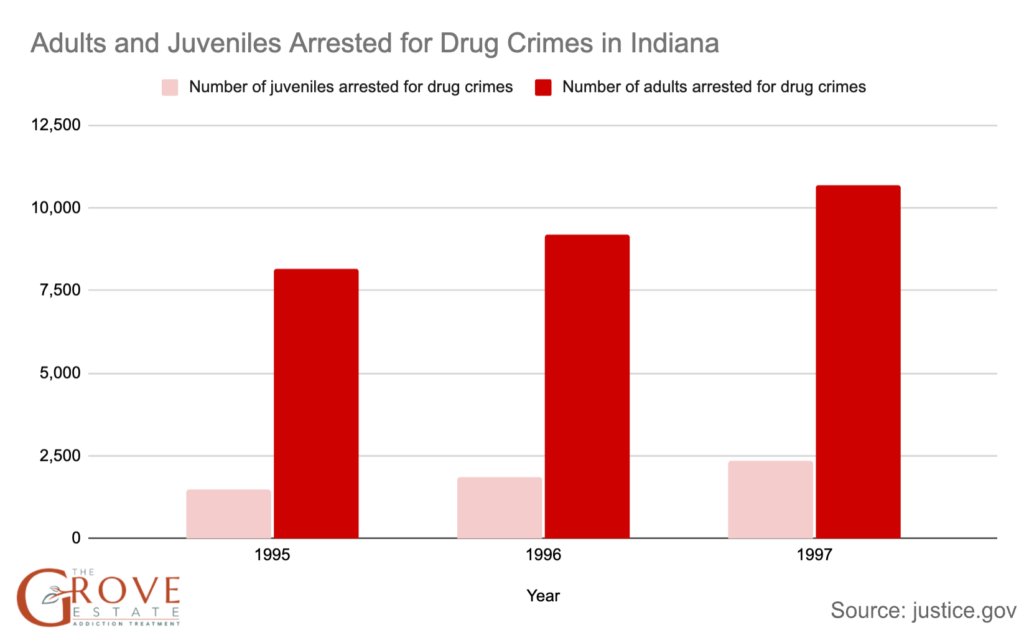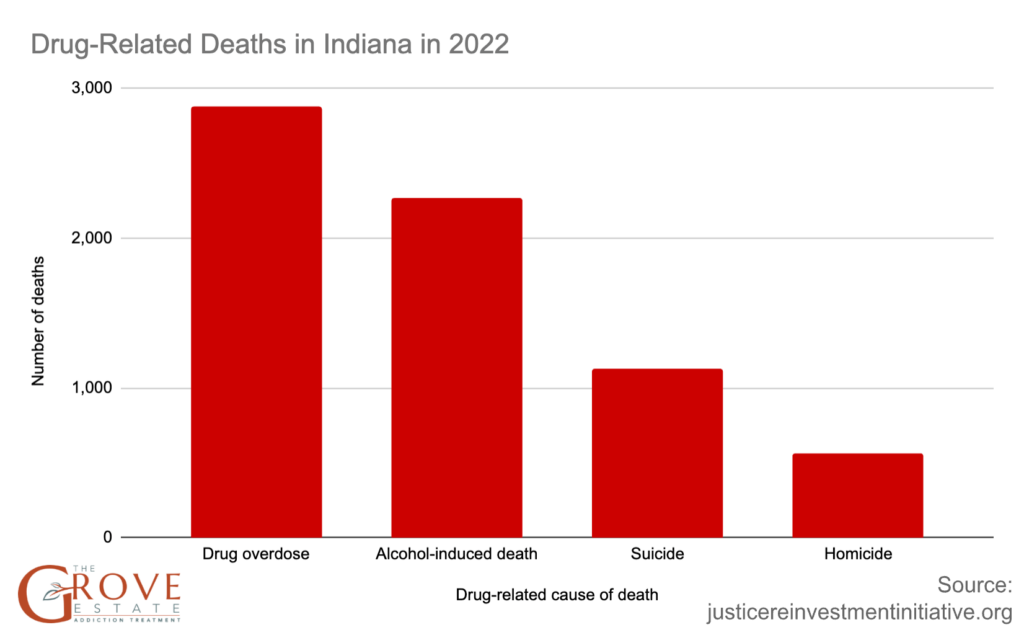Drug-related crimes pose a significant challenge in Indiana and impact individuals, families, and communities statewide. Factors contributing to drug-related crimes include the easy accessibility of drugs, socioeconomic disparities, and the presence of organized drug trafficking networks.
These crimes have far-reaching effects, fueling violence, straining law enforcement resources, and burdening the criminal justice system. Additionally, drug addiction leads to negative health outcomes, economic instability, and social alienation for addicted individuals and their families.
Here are important statistics to know about drug-related crimes in Indiana.
KEY TAKEAWAYS:
- Drug convictions in Indiana saw a notable 103% increase from 2013 to 2017. Drug possession offenses comprised 86% of the total convictions.
- After the 2014 criminal code reform, both dealing and possession offenses experienced a 50% decrease in average advisory sentence duration.
- Marijuana dealing and possession cases surged by 493% and 177%, respectively, from 2013 to 2017, which makes it the most frequently misused drug in Indiana.
- Nearly 20% of Indiana’s overdoses occurred in Indianapolis, contributing to its ranking as the 11th most violent city in the United States in 2020.
- Juvenile drug-related crimes surged from 667 in 1990 to 3,159 in 1998. Approximately 40% of drug-related crimes were committed by juveniles in Indiana.
- Indiana saw a significant rise in methamphetamine lab seizures from 803 incidents in 2007 to 1,231 incidents in 2009.
- Drug overdoses claimed the lives of 2,876 individuals in Indiana in 2022. Opioids accounted for 78% of all drug overdose deaths.
- Northwestern Indiana hosts three of the top 25 areas in the U.S. with the highest gun-related crime rates. Approximately 70% of murders in Gary are directly related to drug distribution or abuse.
Drug Convictions in Indiana
Drug conviction numbers in Indiana include:
- The Indiana Criminal Justice Institute analyzed 8,018 guilty drug offenses with drug possession offenses comprising 86% of the total. The total number of convictions saw a notable 103% rise from 2013 to 2017.
- The average advisory sentence duration for both dealing and possession offenses saw a 50% decrease after the 2014 criminal code reform, with offenses more frequently linked to alternative placement.
- According to Marion County Superior Court, drugs were linked to 62% of assaults, 52% of child abuse incidents, 68% of manslaughter charges, and 49% of murders in 1998.
Convictions in Indiana by Type of Drug
According to the Indiana Criminal Justice Institute, between 2013 and 2017:

- Marijuana-related dealing accounted for 19% of all dealing convictions and 30% of possession convictions. The incidence of marijuana dealing experienced a 493% surge, while possession cases saw a 177% rise.
- Methamphetamine dealing constituted 19% of all dealing convictions and 20% of possession convictions. There was a 112% rise in methamphetamine dealing cases, while possession incidents surged by 502%.
- Cocaine dealing experienced a surge of 381%, while possession cases rose by 447%. In a separate report, it was revealed that The Fort Wayne Police Department seized 1,678 grams of cocaine in 1998 and 1,992 grams in 1999, which reflects an 18% increase.
- Narcotics dealing accounted for 35% of all dealing convictions and 22% of possession convictions. Possession of narcotics witnessed a 32% increase.
Drug-Related Arrests in Indiana
Important drug-related arrest statistics in Indiana include:
- As reported by the Arrestee Drug Abuse Monitoring (ADAM) program, 74% of adult arrestees in Indianapolis in 2001 tested positive for illegal drug use, exceeding the national average of 67%.
- According to the Indiana Youth Institute, the count of juveniles apprehended on drug-related charges statewide surged from 667 in 1990 to 3,159 in 1998.
- In 1999, the Indiana Department of Corrections found that roughly 80% of state prisoners had a notable history of substance abuse.
- The Reception and Diagnostic Center staff and drug abuse counselors within the prison system conservatively estimate that drug abuse directly contributes to around 50% of criminal offenses.
- The Indiana Criminal Justice Institute indicates that between 70% to 80% of criminal offenders have a significant history of drug abuse, with over 25% of adult male inmates incarcerated for drug or alcohol-related crimes.
- According to the Marion County Superior Court, out of nearly 11,000 felony cases filed in 1998, 19% were related to drugs.
- Research conducted by the Indiana Division of Mental Health suggests that 61% of inmates exhibited dependence on alcohol or other drugs in 1996, which translates to approximately 15,000 individuals. The study also reveals a significant portion of juvenile detainees engaged in drug abuse, with 61% abusing marijuana and 27% using other drugs.
- Indiana University reports that roughly 90% of inmates do not receive addiction treatment services, and three-quarters of those incarcerated for drug-related offenses are rearrested for a new offense within five years of their release.
- As of 2007, Indiana had a total of 28 drug courts, out of which 25 were for adults and three for juveniles. The typical age range for participants in adult drug courts, both nationally and in Indiana, is 31-33 years.
- In 2020, the rate of prison incarceration for violent offenses saw a 52% increase compared to 1990, while the rate for drug offenses experienced a 35% decrease, as per the Indiana Criminal Justice Data.
- According to the National Drug Intelligence Center (NDIC) National Drug Threat Survey 2000, a majority of Indiana county sheriff’s and police departments report that approximately 40% of the drug-related crimes in their jurisdictions are conducted by juveniles.

- An Indiana University report states law enforcement agencies reported a surge in methamphetamine lab seizures, rising from 803 incidents in 2007 to 1,231 incidents in 2009. Arrests for possession of barbiturates, benzedrine, and other drugs increased from 1,688 in 2003 to 2,720 in 2007.
- The report also mentions that in 2009, there were 210 fatalities due to alcohol-impaired driving. Indiana saw 22,618 arrests for driving under the influence and an extra 16,936 arrests for public intoxication.
Drug-Related Deaths in Indiana
Drug addiction leads to death by overdose, suicide, and homicide. Here are the important numbers to know:
- According to Indiana Criminal Justice Data Snapshot in 2022, drug overdose claimed the lives of 2,876 individuals, while 2,265 deaths were attributed to alcohol consumption. Additionally, 1,129 individuals died by suicide and 559 people fell victim to homicide.

- In 2019, Indiana ranked 19th in the nation for overdose rates and averaged four deaths per day, as per the Indiana Department of Health. Among these fatalities, Black individuals, comprising only 13% of the state’s population, experienced the highest overdose rate at 28.2 per 100,000 people.
- According to Indiana University, individuals recently released from prison face a 129% higher likelihood of dying from a drug overdose within the first two weeks compared to the general population.
Drug-Related Violence Statistics in Indiana
Violence is a major problem that comes with drug addiction. Here are drug-related violence statistics in Indiana:
- Northwestern Indiana is home to three of the top 25 areas in the United States with the highest incidence of gun-related crimes, according to the Indiana Drug Threat Assessment Report 2001.
- Gary, Indiana, experienced one murder per 970 people in 1997. Over 70% of these murders were directly related to drug distribution or abuse.
- A study conducted by Indiana University-Purdue University Indianapolis studied the overlap of drug overdoses and firearm injuries in Indianapolis from 2018–2020. The study revealed that 75% of census tracts in the city with high rates of firearm injuries also exhibited high rates of opioid overdoses.
- The same study found 27 census tracts with high firearm and overdose rates, showing a composite overdose rate 180 times higher and a firearm injury rate 35 times higher than citywide. Approximately half of the residents in these tracts lived below the poverty line.
- In 2019, Indiana ranked 19th in the nation for overdose rates with an average of four deaths per day. Indianapolis, the state’s largest city and the 12th largest in the nation, contributed to nearly 20% of the state’s overdoses. Additionally, by 2020, Indianapolis had risen to become the 11th most violent city in the country. Firearms were involved in nearly 80% of the city’s 245 homicides, according to the Federal Bureau of Investigation.
Indiana Drug-Related Crime Rates by County
Here’s how drug-related crime varies by county in Indiana:
- As per CrimeGrade’s data, the Indianapolis area experiences a drug-related crime rate of 1.315 incidents per 1,000 residents in a standard year.
- Indiana Drug Threat Assessment report states that Northwestern Indiana, particularly the Lake County HIDTA area, serves as a drug distribution hub for Indiana.
- Lake County’s transportation infrastructure, including railroads, the Port of Indiana, truck depots, and airports, facilitates drug trafficking. Mexican drug trafficking organizations use the region to store and distribute large quantities of cocaine, marijuana, and heroin.
- Northern and central Indiana areas face issues related to powdered and crack cocaine availability, distribution, and abuse. Central and southern regions experience a rise in methamphetamine laboratories and abuse. Heroin is more prevalent in urban areas, while marijuana remains the most commonly abused drug statewide.
- Fort Wayne, Indiana, stands out as one of the cities with the highest rates of drug-related crimes and registers an annual average of 1,307 such offenses. From 2015 to 2020, these crimes have risen by 26%, according to CrimeGrade.
What Is the Addiction Rate in Indiana?
8.5% of the adult population in Indiana meets the criteria for having a substance use disorder. Additionally, 13% of adults in Indiana’s general population reported using an illicit drug in 2023, primarily marijuana.
How Many People Die From Overdose in Indiana?
In 2021, 43 in every 100,000 people died from drug overdose. The number was limited to 15.3 per 100,000 people in 2011. The primary contributor to the surge in drug-related deaths is opioid overdose. There were 2,206 opioid overdose deaths in Indiana in 2021, which represented 78% of all drug overdose fatalities in the state.
Do First-Time Drug Offenders Go to Jail in Indiana?
First-time drug offenders in Indiana face low-level criminal charges, often either Class B or Class A misdemeanors, for possession. Potential penalties include 0-180 days in prison and a fine of up to $1,000 for Class B misdemeanors, or 0-365 days in prison and a fine of up to $5,000 for Class A misdemeanors.
However, possession of narcotic drugs, cocaine, or methamphetamine could lead to Level 6 felony charges, with potential prison sentences of up to 2.5 years and fines up to $10,000.
How does the legal system in Indiana handle drug-related offenses?
Indiana’s approach to drug-related offenses involves a combination of legal repercussions and rehabilitation efforts, aiming to address both the behavior and its underlying causes. Data from Indiana University suggest that a focus on rehabilitation, especially for first-time or non-violent offenders, can lead to better outcomes in terms of reducing recidivism and aiding recovery. This approach is complemented by legal measures that consider relapse statistics, acknowledging the complex nature of addiction as a chronic disease that requires an informed and nuanced response from the legal system.
How does drug addiction impact family dynamics in Indiana?
Family dynamics can be significantly altered by drug addiction, as it introduces stress, mistrust, and emotional turmoil. Families dealing with a member’s addiction often face financial difficulties, emotional distress, and social stigma, which can disrupt relationships and lead to long-term dysfunction. The effects on children can be particularly profound, with increased risks of emotional and behavioral problems.
Furthermore, according to the American Psychological Association, families in which a member suffers from drug addiction are more likely to experience domestic violence, mental health issues, and the necessity for residential detox programs. These programs aim to provide a safe environment for overcoming addiction, emphasizing the need for specialized support structures to address the unique challenges faced by affected families.
Data Sources
3. https://www.justice.gov/archive/ndic/pubs0/660/overview.htm
4. https://crimegrade.org/drug-crimes-fort-wayne-in/
5. https://recoverycentersofamerica.com/blogs/what-is-the-most-dangerous-drug-in-the-state-of-indiana/
6. https://addictions.iu.edu/understanding-crisis/crisis-in-indiana.html
7. https://www.justice.gov/archive/ndic/pubs0/660/660p.pdf
8. https://www.in.gov/health/overdose-prevention/files/Behind_the_Numbers_Report2020_Final.pdf
9. https://policyinstitute.iu.edu/doc/cbcr-crime-brief.pdf
10. https://pubmed.ncbi.nlm.nih.gov/35781347/
11. https://www.in.gov/cji/research/files/TS-Impaired-Driving-2020_IU-PPI.pdf
12. https://www.thetrace.org/2023/11/indianapolis-shooting-drug-data-research/
13. https://www.kff.org/statedata/mental-health-and-substance-use-state-fact-sheets/indiana/
14. https://fsph.iupui.edu/doc/research-centers/Drivers-of-SA-Addiction-DMHA-report.pdf

Share This Post



